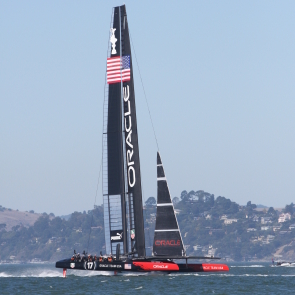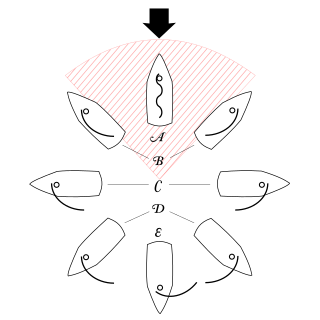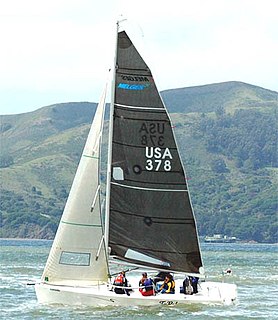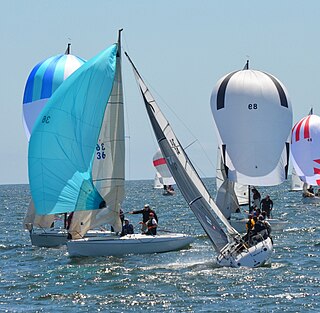Related Research Articles

Sailing employs the wind—acting on sails, wingsails or kites—to propel a craft on the surface of the water, on ice (iceboat) or on land over a chosen course, which is often part of a larger plan of navigation.

Yacht racing is a sailing sport involving sailing yachts and larger sailboats, as distinguished from dinghy racing, which involves open boats. It is composed of multiple yachts, in direct competition, racing around a course marked by buoys or other fixed navigational devices or racing longer distances across open water from point-to-point. It can involve a series of races when buoy racing or multiple legs when point-to-point racing.

A point of sail is a sailing craft's direction of travel under sail in relation to the true wind direction over the surface.

The Sunfish is a personal size, beach launched sailing dinghy. It features a very flat, board like hull carrying a lateen sail mounted to an un-stayed mast.

The winged keel is a new sailboat keel layout fitted on the 12-metre class yacht Australia II, 1983 America's Cup winner.
In fluid dynamics, drag is a force acting opposite to the relative motion of any object moving with respect to a surrounding fluid. This can exist between two fluid layers or a fluid and a solid surface. Unlike other resistive forces, such as dry friction, which are nearly independent of velocity, drag forces depend on velocity. Drag force is proportional to the velocity for a laminar flow and the squared velocity for a turbulent flow. Even though the ultimate cause of a drag is viscous friction, the turbulent drag is independent of viscosity.
The International Offshore Rule (IOR) was a measurement rule for racing sailboats. The IOR evolved from the Cruising Club of America (CCA) rule for racer/cruisers and the Royal Ocean Racing Club (RORC) rule.
Performance Handicap Racing Fleet (PHRF) is a handicapping system used for yacht racing in North America. It allows dissimilar classes of sailboats to be raced against each other. The aim is to cancel out the inherent advantages and disadvantages of each class of boats, so that results reflect crew skill rather than equipment superiority.
A ship must be designed to move efficiently through the water with a minimum of external force. For thousands of years ship designers and builders of sailing vessels used rules of thumb based on the midship-section area to size the sails for a given vessel. The hull form and sail plan for the clipper ships, for example, evolved from experience, not from theory. It was not until the advent of steam power and the construction of large iron ships in the mid-19th century that it became clear to ship owners and builders that a more rigorous approach was needed.

The Olson 30 is a sailboat designed by George Olson of Santa Cruz, CA around 1978. Olson was a surfer and surfboard shaper who decided to design a 30' ultra light displacement boat while on a delivery from Honolulu to Santa Cruz on Merlin, a 68' Bill Lee designed and built ultralight sailboat which had competed in the biennial Transpac race in 1977. During this delivery, Olson came up with the idea while sailing with Denis Bassano and Don Snyder, who lent their initials to the prototype's name, SOB 30. The resulting boat was christened Pacific High, and it was launched in 1978.
Weather helm is the tendency of sailing vessels to turn towards the source of wind, creating an unbalanced helm that requires pulling the tiller to windward in order to counteract the effect.

A sailing yacht, is a leisure craft that uses sails as its primary means of propulsion. A yacht may be a sail or power vessel used for pleasure, cruising, or racing. There is no standard definition, so the term applies here to sailing vessels that have a cabin with amenities that accommodate overnight use. To be termed a "yacht", as opposed to a "boat", such a vessel is likely to be at least 33 feet (10 m) in length and have been judged to have good aesthetic qualities. Sailboats that do not accommodate overnight use or are smaller than 30 feet (9.1 m) are not universally called yachts. Sailing yachts in excess of 130 feet (40 m) are generally considered to be superyachts.
The International Measurement System (IMS) is a system of handicapping sailboats for the purpose of racing that replaced the earlier International Offshore Rule (IOR) system in the early 1990s. It is managed by the Offshore Racing Congress (ORC). In the sailing world it is usually referred to simply as 'IMS'.

The term sportsboat first appeared in the late 1980s and early 1990s to describe trailer sailers that were optimised for high performance at the expense of accommodation and ballast. The very definition of the term "sportsboat" is evolving.

The Boomerang 20 is a sailboat that was designed by Eric Maizey in the late 1960s to race and cruise on Port Phillip in Melbourne Australia, sheltered water but choppy conditions. The original boats were built at the family home in Frankston with the assistance of the kids and neighbours in cold moulded ply. As interest grew and production increased, the majority were fibreglass construction. The hulls were built by contractors such as Bruce Orchard and fitted out at the Maizey home until the growing business took up residence in a factory in Kookaburra St. Frankston. Boomerangs began appearing at major regattas in increasing numbers, and their reputation for excellent sailing qualities and bulletproof design grew with their successful racing results. The class soon gained JOG qualification and so could race in the relevant offshore events. After Eric Maizey's untimely death, the business was sold and the Boomerang was built in Victoria, Australia, by Maison Marine in the 1970s and later by Peninsula Yachts. The class association continued to grow. Many hundreds have been built over a 25-year period, and there are quite a few still around the waterways. The Boomerang 20 has always been a classic. It is one of the all-time best-sellers of the 20-foot trailer sailers,
The E-Boat, was designed by Julian Everitt, and went into production in 1976 and there are in excess of 250 E-Boats built between 1976 and 1984 of which around one hundred and fifty were in the UK. She was designed to comply with IOR rules and is basically a 22 feet, four berth trailer sailer. The E-Boat Offshore One Design is a light displacement flush deck IOR Mini Ton keel-boat with a lifting cast iron keel, designed in 1974. Most boats sailing are in Great Britain, Ireland, The Netherlands and Denmark.
High-performance sailing is achieved with low forward surface resistance—encountered by catamarans, sailing hydrofoils, iceboats or land sailing craft—as the sailing craft obtains motive power with its sails or aerofoils at speeds that are often faster than the wind.

Forces on sails result from movement of air that interacts with sails and gives them motive power for sailing craft, including sailing ships, sailboats, windsurfers, ice boats, and sail-powered land vehicles. Similar principles in a rotating frame of reference apply to wind mill sails and wind turbine blades, which are also wind-driven. They are differentiated from forces on wings, and propeller blades, the actions of which are not adjusted to the wind. Kites also power certain sailing craft, but do not employ a mast to support the airfoil and are beyond the scope of this article.
The Offshore Racing Congress (ORC) is an international body for the sport of competitive sailing and is responsible for the establishment and maintenance of rating and classification standards used to define offshore, that is marine as opposed to inland, yacht racing handicap categories.
Handicap forms for sailing vessels in sailing races have varied throughout history, and they also vary by country, and by sailing organisation. Sailing handicap standards exist internationally, nationally, and within individual sailing clubs.
References
- ↑ Moonbeam VPP polar chart
- ↑ "United States Performance Handicap Racing Fleet". United States Sailing Association. Archived from the original on 2012-03-10. Retrieved 2012-04-04.
- ↑ "IRC Rating". IRC. Archived from the original on 2012-03-23. Retrieved 2012-04-04.
- Claughton, A R; Wellicome, J F; Shenoi, R A (2006). Sailing yacht design: theory. Southampton, UK. pp. 109–143. ISBN 0-85432-829-7.